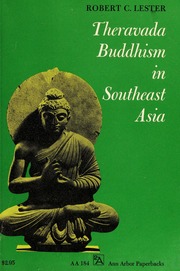Buddhism: Theravada: Main

Theravāda Buddhism: Main

The renowned Sri Lankan scholar Y. Karunadasa examines the Abhidhamma perspective on the nature of phenomenal existence. He begins with a discussion of dhamma theory, which provides the ontological foundation for Abhidhamma philosophy. He then explains the category of "the conceptual" as the Abhidhamma's answer to the objects of common-sense realism. Among the other topics discussed are the theory of double truth, the analysis of mind, the theory of cognition, the analysis of matter, the nature of time and space, the theory of momentary being, and conditional relations. Not limiting himself to abstract analysis, Karunadasa draws out the Abhidhamma's underlying premises and purposes. The Abhidhamma provides a detailed description of reality in order to identify all sources of suffering and thereby point to a complete cure for the problem of suffering.
Theravada Buddhism provides a comprehensive introductory overview of the history, teachings, and current practice of an often misunderstood form of one of the world's oldest religious traditions. This work: (1) explores Theravada Buddhism's origins, evolution, teachings, and practices; (2) considers the practice of Theravada beyond Sri Lanka and Thailand, by exploring a wealth of material from countries including Bangladesh, Cambodia, and Vietnam; (3) reveals its rich and varied traditions, and corrects common misunderstandings about links to other practices, such as early Buddhism or Hinayana Buddhism; and (4) incorporates student-friendly features, including a glossary and other study aids.
Vamsa is a dynamic genre of Buddhist history filled with otherworldly characters and the exploits of real-life heroes. These narratives collapse the temporal distance between Buddha and the reader, building an emotionally resonant connection with an outsized religious figure and a longed-for past. The fifth-century Pali text Mahavamsa is a particularly effective example, using metaphor and other rhetorical devices to ethically transform readers, to stimulate and then to calm them. Scheible's work advocates a new, literary approach to this text by revealing its embedded reading advice (to experience samvega and pasada) and affective work of metaphors (the Buddha's dharma as light) and salient characters (nagas). Scheible argues that the Mahavamsa requires a particular kind of reading. In the text's proem, special instructions draw readers to the metaphor of light and the nagas, or snake-beings, of the first chapter. Nagas are both model worshippers and unworthy hoarders of Buddha's relics. As nonhuman agents, they challenge political and historicist readings of the text. Scheible sees these slippery characters and the narrative's potent and playful metaphors as techniques for refocusing the reader's attention on the text's emotional aims. Her work explains the Mahavamsa's central motivational role in contemporary Sri Lankan Buddhist and nationalist circles. It also speaks broadly to strategies of reading religious texts and to the internal and external cues that give such works lives beyond the page.
André Bareau (1921–1993) was one of the foremost scholars of Buddhism of his generation. Dissatisfied with piecemeal and contradictory information on early Buddhist schools, he set out to construct a coherent and authoritative overview, which has remained the standard treatment in the field since its appearance in 1955. This book offers a close description and analysis of Bareau’s findings on the history, geographical whereabouts, and doctrinal positions of early schools of Buddhism. He systematically presents data from a diverse array of sources: texts in canonical Buddhist languages (Pāli, Sanskrit, Tibetan, and Chinese), inscriptions, and accounts of Chinese pilgrims to India. The result is an encyclopedic resource on thirty-four schools of Indian Buddhism and the approximately five hundred doctrinal theses by which they are differentiated. Bareau’s genius was to conceive a plan to draw on an exhaustive range of primary sources preserved in all the major Buddhist languages and to conduct a comprehensive synthetic analysis, thus creating an authoritative picture. He provides several appendices, including summary tables of all doctrinal points discussed. This work will be used by students and scholars as a primary resource and starting point for any discussion on the history and doctrines of early Buddhism.
This work describes in evocative detail the experiences and achievements of Nepalis who have adopted Theravada Buddhism. This form of Buddhism was introduced into Nepal from Burma and Sri Lanka in the 1930s, and its adherents have struggled for recognition and acceptance ever since. With its focus on the austere figure of the monk and the biography of the historical Buddha, and more recently with its emphasis on individualizing meditation and on gender equality, Theravada Buddhism contrasts sharply with the highly ritualized Tantric Buddhism traditionally practiced in the Kathmandu Valley. Based on extensive fieldwork, interviews, and historical reconstruction, the book provides a rich portrait of the different ways of being a Nepali Buddhist over the past seventy years. At the same time it explores the impact of the Theravada movement and what its gradual success has meant for Buddhism, for society, and for men and women in Nepal.
This book explains the Buddhist doctrine of anatta ("not-self"), which denies the existence of any self, soul, or enduring essence in man. The author relates this doctrine to its cultural and historical context, particularly to its Brahman background. He shows how the Theravada Buddhist tradition has constructed a philosophical and psychological account of personal identity on the apparently impossible basis of the denial of self. Although the emphasis of the book is firmly philosophical, Dr. Collins makes use of a number of academic disciplines, particularly those of anthropology, linguistics, sociology, and comparative religion, in an attempt to discover the "deep structure" of Buddhist culture and imagination, and to make these doctrines comprehensible in terms of the Western history of ideas.

























